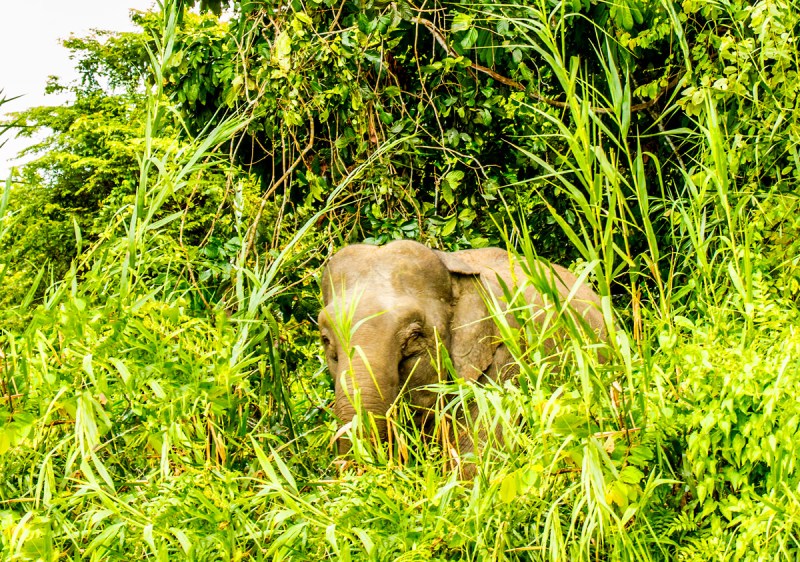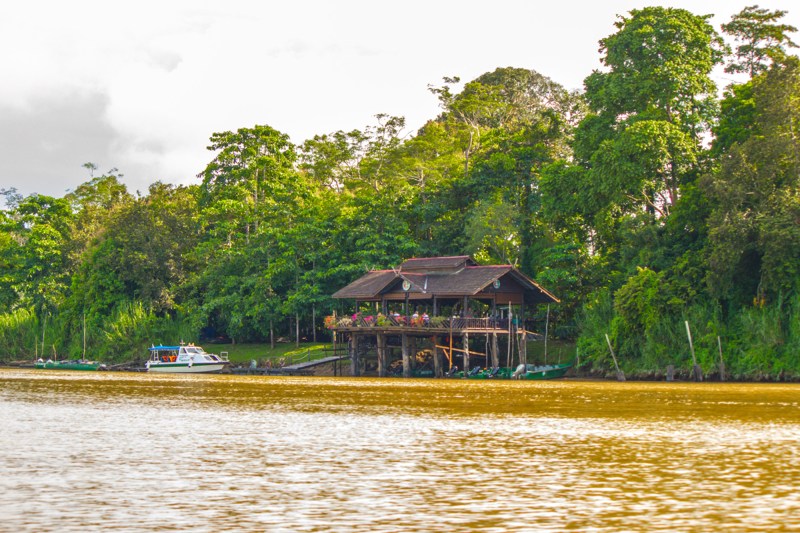Proboscis Monkey © D. M. DeKraker
Malaysian Borneo

Borneo is the third largest island in the world. Located in Asia, it is divided by three governments, Indonesia, Malaysia, and Brunei. It’s rainforests have well over 200 species of mammals and 400 species of birds, some found nowhere else, making it one of the most diverse wildlife habitats in the world. New species are still being found there.
I visited Malaysian Borneo, because I wanted to see the unique wildlife in Borneo, mainly the orangutan. The state of Sabah in northern Borneo has the most accessible protected wildlife areas to view the animals.
Getting to Sabah, Borneo
Kuala Lumpur, the capital of Malaysia, is a major airport hub. Malaysia Airlines flies from Kuala Lumpur International Airport to Kota Kinabalu and Sandakan. Local Malaysian airlines may use the separate airport nearby. It is also possible to fly directly to Malaysian Borneo. There are a few international flights to Kota Kinabalu in the northeast part of the state of Sabah.
My Trip Information.
I took a stopover on an Overseas Adventure Travel trip to Indonesia that included airfare. They allow stopovers for very little extra money. I stopped over in Kuala Lumpur. I had booked my round trip flight from there to Sandakan in the state Sabah, in the northwestern part of Borneo. Borneo Eco tours picked me up from my hotel in Sandakan.

Sepilok Orang Utan Rehabilitation Center
Our first stop was to see Orangutans being fed at Sepiloc Orangutan Sanctuary. These orangutans were orphaned. They are being taught to live in the wild. Normally baby orangutans live with their mother for six to nine years, learning how to survive in the wild. They live in treetops in the wild, but must be taught to climb. At the center, they are paired with older orphans to learn. The orangutans are free to roam around the surrounding forest, but are still fed twice a day at the center.
Orangutans are endangered in the wild. People like orangutan babies for pets. The government removes them from the people and takes them to a rehabilitation center like Sepilok Orang Utan Rehabilitation Center. The government is trying to educate people to prevent the pet trade.
However, much of the orangutan’s habitat in Malaysian Borneo, the rainforest, has been cut down to plant palm oil trees. This is a lucrative crop. Along the Kinabatangan river, the rainforest is only a few hundred feet wide, with plantations adjoining it. Orangutans that wander into the palm oil plantation face death. If the mother is carrying a baby, the baby is saved and taken to a rehabilitation center. The government has put up ropes in the trees over streams that run into the Kinabatangan River so the orangutans and monkeys do not have to swim in the crocodile infested water to get across. The animals used to be able to cross where the streams were narrower, but now that is plantation land. Small monkeys sleep on these ropes for protection from predators.

Sukau Rainforest Lodge.
After lunch, we boarded a speedboat for the ride out into the Sula Sea to the mouth of the Kinabatagan River, then upriver to the Sukau Lodge. We stopped along the way to see wildlife. Some Bornean Pigmy Elephants were feeding along the bank of the river. These elephants are smaller than the Asian elephants, but are still quite large, about 8 feet tall. There are villages as well as parts of the Kinabatagan Wildlife Sanctuary along the river.

Viewing Wildlife.
We left the lodge to view the wildlife along the river, going out several times a day and in the evening. The lodge uses skiffs with electric motors. . We saw numerous different types of monkeys. At one point, we saw small monkeys hopping from the ground into a bush one after another,. They followed each other up into the trees. It was really cute
We saw a lot of different animals up close from the convenience of the boat, including 6 foot long monitor lizards, and lots of birds.
Proboscis Monkeys
Proboscis monkeys are only found in Borneo. We saw a number of them including the one at the top of the page. When the Dutch traders first came to the area, local natives thought that the traders were related to the proboscis monkey, because the traders had the long nose of Europeans instead of the short nose of the Asians, and they wore trousers that looked like the monkey which has different hair color on its legs.
Gomantong Cave
One afternoon, we went by boat to a dock where we got in a car to drive to see Gomantong Cave. It has large numbers of bats as well as a large number of swifts. While we were there, men were harvesting the swift’s nests. These are used to make bird’s nest soup. The nests are made of the swifts saliva that drys white and feathers. The whiter the nest the more valuable it is. The cave was really interesting, but also filled with cockroaches.
Most people at Sukau Rainforest Lodge stayed for two nights and then went to other lodges. I stayed an extra night and did not go to other lodges because of the shortness of my trip.

Sun Bear Conservation Center
We visited the Bornean Sun Bear Conservation Center in Sepilok on the last day after returning to Sandakan by boat.
References
Wikipedia
Sukau Rainforest Lodge in Borneo.
Sun Bear Conservation Center, Borneo, Malasia
Gomantong Cave in Malaysian Borneo
Books
Lonely Planet Borneo (Travel Guide)
Borneo: Sabah Sarawak Brunei (Bradt Travel Guides)



